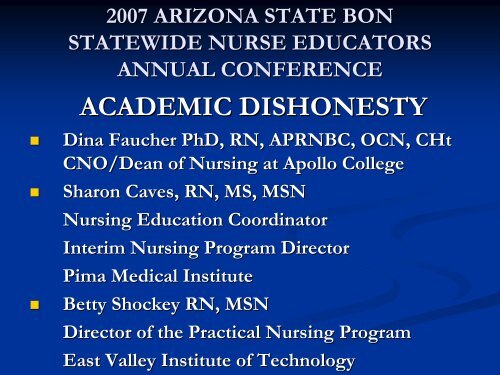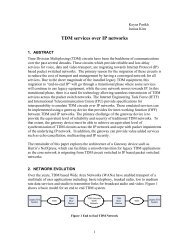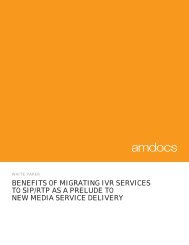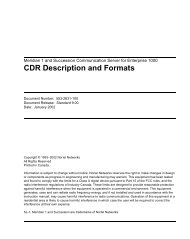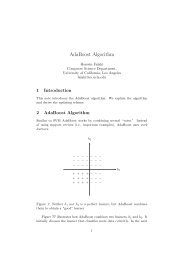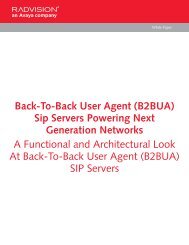Innovative Cheating techniques by Dr. Dina Faucher - Arizona State ...
Innovative Cheating techniques by Dr. Dina Faucher - Arizona State ...
Innovative Cheating techniques by Dr. Dina Faucher - Arizona State ...
Create successful ePaper yourself
Turn your PDF publications into a flip-book with our unique Google optimized e-Paper software.
2007 ARIZONA STATE BONSTATEWIDE NURSE EDUCATORSANNUAL CONFERENCEACADEMIC DISHONESTY• <strong>Dina</strong> <strong>Faucher</strong> PhD, RN, APRNBC, OCN, CHtCNO/Dean of Nursing at Apollo College• Sharon Caves, RN, MS, MSNNursing Education CoordinatorInterim Nursing Program DirectorPima Medical Institute• Betty Shockey RN, MSNDirector of the Practical Nursing ProgramEast Valley Institute of Technology
Topics and Objectives:• 1. <strong>Innovative</strong> cheating <strong>techniques</strong>:<strong>State</strong> the various innovative cheating<strong>techniques</strong> students have utilized.• 2. Prevention, detection & atonement:Review strategies designed to reduce academicmisconduct in the classroom, with outsideassignments, clinical setting, and duringexams.• 3. Power of policy:List and define important decisions required to createa system of policy and procedures for faculty andstudents regarding cheating, plagiarism and collusion.
<strong>Innovative</strong> <strong>Cheating</strong>TechniquesUsed when taking anExam—classroom or on-linePaper writing----PlagiarismGroup workClinical Practice<strong>Dr</strong>. <strong>Dina</strong> <strong>Faucher</strong>
<strong>Cheating</strong>• Classified in three primary domains:• 1. <strong>Cheating</strong> <strong>by</strong> taking, giving or receivinginformation from others• 2. <strong>Cheating</strong> through the use of forbiddenmaterials or information• 3. <strong>Cheating</strong> <strong>by</strong> circumventing the process ofassessment
Continued…LowLow-Tech <strong>Cheating</strong>:• Communicate with sign language or a code for transmittinganswers such as clicking of pencils, foot tapping, capturning on head or gestures• Eraser with information written on it is passed back andforth• “Storyteller” or “Chain Gang” someone/many who havealready taken the exam; make a detailed study guide;taking notes during exam review session• Needing to go to the bathroom during the exam time—notes in a bra/underwear or a textbook hidden <strong>by</strong> the trashcan• Printing the computer exam after they take it• Not citing another’s s work
Continued… Forbidden materials orInformation• High-Tech:• Numeric devices can be used to communicate a questionnumber or correct answer—text messaging via cell phones• Two micro recorders (offers auto-reverse, dual-tape speedsfor up to 3 hours of continuous recording, variable voiceactivation, auto shut-off and highly sensitive) that permit atest taker to whisper test questions that can be concealed inan eyeglass case, sewn into a jacket, fitted into a pager orbaseball cap, tie pin, etc…• I pods to block out noise that has the review of notes beingread on it
Continued… Forbidden materials orInformation• Still cameras concealed in wristwatches, cigarettelighters or campaign buttons that can be used tophotograph entire test booklets during an exam thatcan then be mailed, faxed or e-mailed eanywhere• Ultraviolet pens can be used to write the test onto aplain “blank” paper and then viewed under anultraviolet light source• Internet access while taking a computer test
<strong>Cheating</strong> <strong>by</strong> Circumventing theProcess of Assessment• The student can’t t take the test or provide the assignment on the appointedday because:• Once again the “grandmother passed away”• Student claims to be “deathly ill”• “Sacrificallamb” students take turns taking an exam early (appointment or out oftown) so they can share with the other students• Forgot paper at home, had printing issues; claims they e-mailed ethe paper to theinstructor already; states other student was responsible for submitting work anddid not do so• In the clinical setting the student:• Goes to another health care provider or does the procedure without beingevaluated• Not prepared for clinical=forgot clinical prep work at home• Does not report key information or an error• Fabricates assessment information• Cheats on urine drug screen: containers that keep urine warm (rectum, vagina orbelted to the abdomen.
<strong>Innovative</strong> <strong>Cheating</strong> TechniquesSummary• Students utilize low and high level innovativecheating <strong>techniques</strong> when taking exams, writingpapers, with group work and during clinical.• <strong>Cheating</strong> occurs <strong>by</strong> taking, giving and receivinginformation from others; <strong>by</strong> using forbiddenmaterial or information; and <strong>by</strong> circumventingthe process of assessment.
Prevention, Detection &AtonementSharon Caves, RN, MS, MSN
Prevention• Formal assessment of student attitudetoward cheating, moral developmentalstage and writing style• Binding student behavior contract/banner• Academic Integrity Week/Social NormCampaign• Written precautions and punishments insyllabi, exams, assignments, web pages• Teach, and teach again, ethicalbehavior….and teach again..and again
Traditional <strong>Cheating</strong> Deterrents• Testing:• Pen, pencil and calculator provided• Desk arrangement• Student proctors• Minimize multiple choice• Discussion vs memorization questions• Simultaneous randomized multiple version ofsame exam
Traditional <strong>Cheating</strong> Deterrents• Role Model• RespectCont’d• Interest in learning• Open communication• Trust• Integrity• Fairness
Traditional <strong>Cheating</strong> DeterrentsCont’d• Papers and assignments• Paper as process, not product• Group activities• Narrow focus/topic/format• Encourage creativity vs ‘research’• Emphasize importance of topic thru writtenfeedback• Help with time management of project• Clinical prep work reviewed <strong>by</strong> instructor atbeginning of clinical day
DeterrentsforHi-Tech <strong>Cheating</strong>• Cut off wireless hot spots/access during exams• Demand surrender of cell phones, calculators,books, bags, caps• Software/web based authentication databases• Software to observe programs running oncomputers during exams• Cameras in classroom• Review websites that rate instructors• Frequently change online student log-in codesand passwords
Faculty Considerations WithAtonement Decisions• Faculty discussion/agreement on misconductpunishment, probability of being caught, severitylevels, frequency of occurrence• Methods that are unacceptable to student bodyimpede student engagement, motivation &learning• Policies often seen as confusing, ambiguous,time consuming• Values’ expectations often more successful thanextensive list of banned behaviors
Atonement for Misconduct• Student rated as most appropriate and effective: Listedin descending order - most effective to least effective -• Methods that involve ‘negotiation’/studentparticipation• Tell student to keep eyes on own paper, do ownwork, give verbal warning• Talk to student after class• Student to receive failing grade on assignment orexam• Student to go before review board (seen as equal todoing nothing)
Atonement for MisconductCont’d• Student rated as most appropriate and effective –cont’d:• Receive failing grade in course• Expulsion from school• Re-write different paper or re-take differentexam with extensive deduction of total pointsor possible grade• Suspension/probation• Tear up exam/assignment in front of class• Do nothing
Misconduct Prevention:Summary• Teaching faculty and students how torecognize and address dishonest behaviordecreases misconduct• 2004 study of 1,700 nursing students – “twomost effective deterrents to cheating were theprofessor announcing the penalties forcheating and requesting that the students notcheat”
Misconduct Detection:Summary• <strong>Cheating</strong> occurs when opportunities areenhanced and surveillance is minimized• Familiarize all faculty with webbased/software authentication database use• 20-40% US professors (2001) said they hadnot reported a student caught cheatingbecause of ambiguous, oppressivepolicies/procedures or unpleasant nature ofprocess
Misconduct Atonement:Summary• Must be seen as appropriate and effective <strong>by</strong>student body• Most effective involves student ‘negotiatedcontracts’• Understand line between punishment andhelping student learn from mistake• 2006 Scholastic Choices survey – only 5-8% 5 8%students are chronic offenders
The Power of PolicyBetty Shockey RN, MSN
Establishing a Culture ofAcademic Integrity throughPolicy• May 2007 “<strong>Arizona</strong> <strong>State</strong> Board of NursingRegulatory Journal” article:• “<strong>Cheating</strong> is profoundly unfair to patients” <strong>by</strong>Pam Randolph• Recommends that faculty and nursing programadministrators deter cheating <strong>by</strong>• “Establishing a culture of academic integrity.”• <strong>Cheating</strong> behaviors on the part of a nurse or anursing student can have serious implications inthe patient care arena.
Continued… Establishing a Cultureof Academic Integrity through Policy• “Reports of nursing student cheating on examsgive the public serious reasons to question thecompetency and qualifications of nurses”• Faculty must assume responsibility equally withstudents for reducing academic dishonesty.• Professor Brian Fagan, University of California• Establishing a code of academic integrity beginswith our written Policies and Procedures.
Policy• A specific statement of principles/guidingactions that provide a basis for consistentdecision-making• A broad statement of intent• <strong>State</strong>ment of what and why• <strong>State</strong>ments usually define academicdishonesty followed <strong>by</strong> a list of expectationsand prohibited behaviors (cheating,plagiarism, collusion)
• <strong>Cheating</strong>:Continued… Policy• Unauthorized use of information or study guides inany academic exercise• Plagiarism:• Academic theft• The use of another’s ideas or words without propercredit• Collusion:• Occurs when a Faculty or student knowingly helpsanother student to perform any of the acts of cheatingor plagiarism• Suggested that the expectations be written in eachsyllabus• Nursing program policies follow those of the parentinstitution and are not in conflict
Considerations for Policy• Instructors should provide clearexplanations of expectations of academicand clinical integrity.• Explain what students “can do”. What youallow and not considered dishonest.• Written affirmation on exams/assignmentsthat the Code of Academic Integrity hasbeen followed.
Procedure• A series of steps followed in a regular ordertaken to implement policy• Much more difficult than policy
Thoughts About DisciplineProcedure for Academic Dishonesty• Charges involving academic dishonesty areusually initiated <strong>by</strong> faculty.• Others may call it to the attention of thefaculty: other students, librarian.• The faculty in most situations has theauthority to handle the misconduct directly.• Documentation must provide/establish guiltof student.• Standard forms are best to use fordocumentation of academic dishonesty.
Continued… Thoughts About DisciplineProcedure for Academic Dishonesty• What are the sanctions? Are there levels that gofrom minor to severe or criminal behaviors?• How does one provide for “consistent decisionmaking”?• Do you have a “paper trail” that is shared forrepeated offenders?• Are severe sanctions, with a grade of F and ordismissal, identified on the transcript as“Academic Dishonesty”? ? Consult your legaldepartment.• Do you have the support of the parent school if astudent appeals the judgment?• How are disciplinary records maintained? Whereand time period?
Example of Levels of ReprimandProcedures• From the Rutgers Code of Student Conduct,1997:• The policy on Academic Integrity wasformulated <strong>by</strong> a committee that consultedmany other major public institutions toformulate policy and procedure.
Continued… Example of Levels ofReprimand Procedures• The Rutgers’s Procedure has four levels• Level I• Failure to footnote• Sanction: make up assignment• Level II• Quoting directly without acknowledging source• Sanction: failing grade for assignment• Level III• Premeditation (planned dishonesty) or is preceded<strong>by</strong> one or more violations• Sanction: one semester suspension• Transcript notice
Continued… Example of Levels of• Level IVReprimand Procedures• Most serious breach, considered criminal: stealing orforging an exam, having a substitute take the exam,making a clinical error and not reporting it• Sanction: expulsion from University with notation of“Academic disciplinary separation” on transcript• Consideration for harshness of sanctions may include:• Degree of premeditation• Acknowledgement of the violation and consequences
Sanctions On Transcripts• George Washington University removessanctions from the transcript following the 2year time period.• Placement on transcripts can impact thestudent’s s academic career.• It can influence military careers, highereducation opportunities or job offers.Students need to be told of thispolicy/procedure.• Might be a good deterrent, but check withlegal department
Faculty Collusion• Faculty responsibility to keep the academicintegrity must be made clear.• Responsibility needs to be addressed frequentlythroughout the year at faculty meetings.• Faculty that, knowingly, aid students in academicdishonesty, must be given sanctions.• Consequences for faculty that participate in anyacademic or clinical dishonesty should be writtenand included in a faculty handbook.• A whistle blowing policy to safeguard the reporterof academic dishonesty should be incorporated inpolicies.
Power of PolicySummary• Create a system of policies and procedures forfaculty and students on academic dishonesty.• Provide a basis for consistent decision making inthe policy and procedure statements.• Promote and foster student and faculty integrity<strong>by</strong> listing the policy on cheating in the syllabi.• Support faculty in the decision making whensanctions must be made.
Continued… Summary• Develop a system of documentation thatprovides data to support accusations ofdishonesty. May be considered a formalwritten charge.• Be expedient in the process.• Provide rules and procedures for studentrights and grievance• Develop a” a paper trail” that will providefuture faculty facts in case new violationsoccur.
Continued… Summary• Keep records as required <strong>by</strong> the program andinstitution.• Keep students informed that academic dishonestymay go on permanent records (transcripts) asacademic dishonesty for a period of 2-3 years.• The transcript marking for dishonesty mayinfluence career and upper education possibilities.• Incorporate a Code of Academic Integrity.• The Code may be used with affirmations on eachexam or written assignments stating in some way“I did not cheat”.
Open Discussion• What is your experience with academicdishonesty in regards to:• <strong>Cheating</strong> <strong>techniques</strong>• Prevention, detection or atonement measures• Policies and procedures
References:• Baxter, P.E., Boblin, , S.L. The moral development of baccalaureate nursing students:understanding unethical behavior in classroom and clinical settings. Journal of NursingEducation. 2007; 46:20-27.27.• Bowen, R.W. Academic dishonesty cancels academic freedom. Change. . 2006; 38:1.• Brown, D.L. Spotlight on…cheating must be okay – everybody does it! Nurse Educator. 2002;27:6-8.8.• Buckley, M.R., Wiese, D.S., Harvey, M.G. An investigation into the tdimensions of unethicalbehavior. Journal of Education for Business. 1998; 73: 284-291.291.• Burrus, , R.T., McGoldrick, , K.M., Schulmann, , W. Self-reports of student cheating: does adefinition of cheating matter? Journal of Economic Education. 2007.07.• Calluzzo, , V.J., Cante, , C.J. Ethics in information technology and software use. Journal l of BusinessEthics. 2004; 51: 301-312.312.• Carter, S.L., Punyanunt-Carter, Carter, N.M. Acceptability of treatments for cheating in the collegelegeclassroom. Journal of Instructional Psychology. 2006; 32: 212-216.216.• Center for Teaching Advancement and Assessment Research, Policy on Academic Integrity forUndergraduates and Graduate Students, Rutgers University, 1997http//ctaar.rutgers.edu/integrity/policy.html• Champoux, , J.E. At the cinema: aspiring to a higher ethical standard. Academy of ManagementLearning & Education. 2006; 5; 386-390.390.• Clemson Academic Regulations: Academic Integrity, 2002www.cs,clemson.edu/academic_integrity_2002• Cochran, J.K., Aleksa, , V., Chamlin, , M.B. Self-restraint: restraint: a study on the capacity and desire for self-control. Western Criminology Review. 2006; 7: 27-40.
References Cont’d:• Damast, , A. Duke works to stem Fugua fallout. Business Week Online. 2007; 6.http://www.BusinessWeekOnline.com. . Accessed 4 May 2007.• Dyr<strong>by</strong>e, , L.N., Thomas, M.R., Huntington, J.L., Lawson, K.L., Novotny, P.J., PSlaon, , J.A.,Shanafeet, , T.D. Personal life events and medical student burnout: a multicenter study. AcademicMedicine. 2006; 81: 374-384.384.• Eastman, J.K., Iyer, , R., Eastman, K.L. Addressing academic dishonesty: the implications ions forbusiness schools, professors, and students. Journal for Advancement ent of Marketing Education.2006; 9: 1-8. 1• Etter, , S., Cramer, J.J., Finn, S. Origins of academic dishonesty: ethical orientations and personalityfactors associated with attitudes about cheating with information n technology. Journal of Researchon Technology in Education. 2006; 39; 133-155.155. http://www.lste.orgwww.lste.org. . Accessed 15 May 2007.• Frost, J., Hamlin, A., Barczyk, , C. A survey of professor reactions to scenarios of academicdishonesty in American universities. Journal of Business Inquiry. . 2007; 11-18.18.• Glater, , J.D. Students finding new ways to cheat. The <strong>Arizona</strong> Republic. 21 May, 2006.• Go ahead and cheat. Maclean’s. . 2007; 120. Editorial.• Granitz, , N., Loewy, D. Applying ethical theories: interpreting and responding to studentplagiarism. Journal of Business Ethics. 2007; 72: 293-306.306.• Gulli, , C. <strong>Cheating</strong>? Who us? Maclean’s. . 2007; 7: 41.• Gulli, , C., Kohler, N., Patriquin, , M. The great university cheating scandal. Maclean’s. . 2007; 120:32-36.36.• Hard, S.F., Conway, J.M., Moran, A.C. Faculty and college student t beliefs about the frequency ofstudent academic misconduct. The Journal of Higher Education. 2006; 06; 77: 1058-1080.1080.• Iyer, , R., Eastman, J.K. Academic dishonesty: are business students different dfrom other collegestudents? Journal of Education for Business. 2006; 101-108.108.
References Cont’d:• Klein, H.A., Levenburg, , N.M., McKendall, , M., Mothersell, , W. <strong>Cheating</strong> during the college years:how do business school students compare? Journal of Business Ethics. 2006; 72: 197-206.• Kolanko, , KM, Clark, C, etal, , Academic dishonesty, bullying, incivility and violence: difficultchallenges facing nurse educators. Nursing Education Perspectives, s, Jan/Feb. 2006, 27 (1), 34-43.43.• Lanier, M.M. Academic integrity and distance learning. Journal of Criminal Justice Education.2006; 17: 245-261.261.• Malesic, , J. How dumb do they think we are? Chronicle of Higher Education. 2006; 53: 2-3. 2 3.• Paulos, , L. Breaking the rules. Scholastic Choices. 2007; 22: 10-13.13.• Randolph, Pam, Education Corner, <strong>Arizona</strong> <strong>State</strong> Board of Nursing Regulatory Journal, Vol.2 No1 May 2007• Rawwas, , M., Swaidan, , Z., Isakson, H. A comparative study of ethical beliefs of master of businessadministration students in the United <strong>State</strong>s with those in Hong Kong. Journal of Education forBusiness. 2007; 146-158.158.• Ridenour, Joey, <strong>Cheating</strong> is profoundly unfair to patients, <strong>Arizona</strong> <strong>State</strong> Board of NursingRegulatory Journal May 2007, 4-5. 4 5.• Solomon, M.R., DeNatale, , M.L. Academic dishonesty and professional practice: a convocation.Nurse Educator. 2000; 25: 270-271.271.• Solomon, M.R., DeNatale, , M.L. The moral development of baccalaureate nursing students:understanding unethical behavior in classroom and clinical settings. Journal of NursingEducation. 2000; 46: 20-27.27.• Sorensen, D. <strong>Cheating</strong> in the news. Caveon Test Security Newsletter. 2007; 3 August 2007.• Troop, D. You’re never gonna believe this one. Chronicle of Higher Education. 2007; 53: 4.• Universities simply have to do better. Maclean’s. . 2007; 120: 4. Editorial.• Wolverton, , B. As graduation rates rise, so do fears of academic shortcuts. . Chronicle of HigherEducation. 2006; 53: 39.


